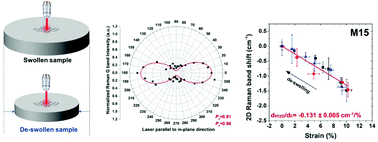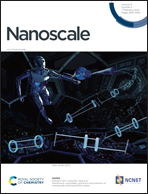Realising biaxial reinforcement via orientation-induced anisotropic swelling in graphene-based elastomers†
Abstract
The biaxial mechanical properties constitute another remarkable advantage of graphene, but their evaluation has been overlooked in polymer nanocomposites. Herein, we provided an innovative and practical method to characterise biaxial reinforcement from graphene via swelling of elastomers, where graphene nanoplatelets (GNPs) were controlled to be oriented in-plane. The in-plane-aligned graphene imposed a biaxial constraining force to the elastomer during the swelling process that led to the anisotropic swelling behaviour of the bulk nanocomposites. This unconventional swelling behaviour was successfully modelled using statistical mechanics. Novel in situ Raman band shift measurements were also performed during the de-swelling process of the samples. The characteristic 2D band shift of the GNPs, imposed by stress transfer during the de-swelling procedure, was of the order of 0.1 cm−1 per % strain, enabling the calculation of the effective biaxial Young's modulus of the GNPs in the nanocomposites (∼2 GPa). The determination of the biaxial modulus of GNPs contributed to the evaluation of their Poisson's ratio (∼0.34), which is very important but highly impractical to be measured directly on a nanoscale-sized specimen.

- This article is part of the themed collection: Editor’s Choice: Optical Spectroscopy of 2D materials


 Please wait while we load your content...
Please wait while we load your content...